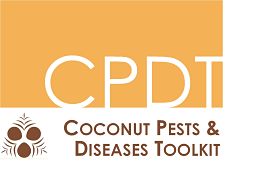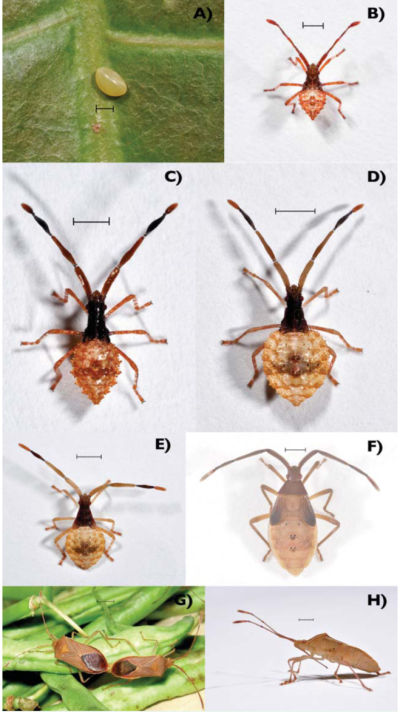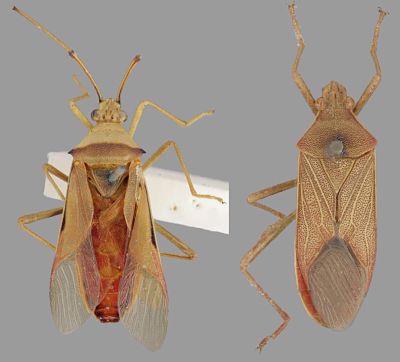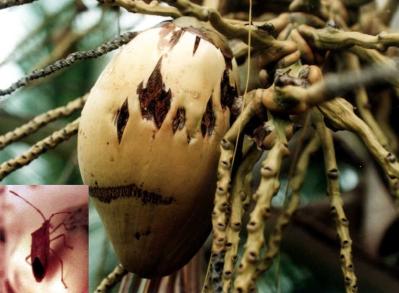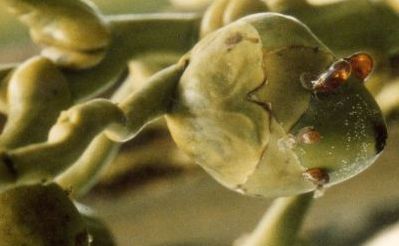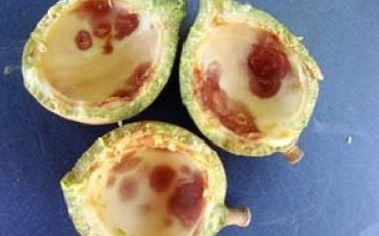Coconut bug
The coconut bug (Pseudotheraptus wayi) is a pest of coconut and other important crops that is not found in the Pacific. The coconut nutfall bug (Amblypelta cocophaga) is widespread in Fiji and also found in Papua New Guinea and the Solomon Islands.
Common nameCoconut bug |
Scientific namePseudotheraptus wayi (currently only found in Africa) |
on this page: Life-cycle and identification : Symptoms : Impacts : Distribution : Prevention : Controlling coconut bug : Information sources and further reading
Life-cycle and identification
The coconut bugs are sap-sucking insects. On coconut they feed mainly on the flowers and fruit, on other plants they often feed on young growing shoots. Individuals go through 6 immature life stages (egg and 5 nymphal stages) that look similar to the adult but do not have wings, before becoming adult with wings.This is called incomplete metamorphosis. Development from an egg to an adult can take up to 6 weeks.
EggsAround 74-100 eggs can be laid singularly on the underside of older leaflets, near the base. Sometimes they are laid on the young fruits or flowers. The smooth, oval eggs are around 2 mm long (right image A). Pseudotheraptus wayi eggs are a creamy colour when laid and change to a reddish-brown colour before hatching. Amblypelta cocophaga eggs change from a gold-green colour to wine red. The eggs hatch after 6-8 days. NymphsNymphs look very similar to adults but lack wings, they get bigger at each of the 5 instars (growth stages). The 1st instar nymphs seek out the inflorescences (all parts of the flowers). Only a few will arrive on the flowers. The nymphs will feed on the succulent parts such as stem and young branches or the base of male flowers where the fleshy spike of tiny flowers (spadix) is developing. Female flowers and young nuts are fed on by the older nymphs. The 5 nymphal stages last around 5 weeks in total. |
Life stages of coconut bug. A) Egg, B) 1st instar, C) 2nd instar, D) 3rd instar, E) 4th instar, F) 5th instar, G) Adults (male on the left), H) Side view of adult (© Fabian Haas, ICIPE) |
Adults
| The adults of two species of coconut bug, Amblypelta cocophaga and Pseudotheraptus wayi, look slightly different from each other.
The back of Amblypelta cocophaga is a brown-red colour and it has yellowish legs and underside. Females are around 15–16 mm long, while males are slightly shorter at 13-14 mm. Pseudotheraptus wayi is reddish brown on its back and its underside is pale brown with pink spots. Females are around 13–16 mm long while males are slighter shorter at 12-14 mm. Both species have long cylindrical antennae (as long as their body) and veined, leaf-like wings. The adults can be found feeding on young nuts and female flowers, usually in the early morning and late afternoon. They can take flight quickly, especially when disturbed. Adults will avoid direct sunlight and heavy rain. They prefer cloudy days but not overcast. Adult males live for around 84 days and females 73 days. |
Comparison of the two coconut species. Adults of Amblypelta cocophaga (left) and Pseudotheraptus wayi (right) (© Tristan Bantock and The Trustees of the Natural History Museum) |
SymptomsThe most recognisable symptoms of the coconut bug are the brown spots (necrotic lesions) that appear on the young nuts after feeding. These lesions are often hidden under the scales at the base of the young nut. The lesions are made by toxic saliva injected into the nut as the coconut bug feeds. The lesions can become longer and appear more like a crack after the nut grows, if it stays attached to the palm. They may have gum oozing out of them (gummosis). This damage often causes the young nuts to die and fall early. However, nuts often fall naturally before maturity depending on the vigour of the palm. |
Cracks appearing on the coconut from necrotic lesions made by the coconut bug (lower left corner) (© Bernhard Loehr, ICIPE) |
Lesions and oozing gum on fallen nuts is a good indication of coconut bug feeding.
If the nuts are 3 months or older, they may not fall before maturity. Instead they will have stunted and abnormal growth.
Additionally, necrotic lesions can be seen externally and internally.
Pseudotheraptus wayi nymphs have been observed in East Africa feeding on other succulent parts of the palm (stems, leaves, inflorescences) causing necrosis and wilting.
|
Gum oozing out of from lesions made on a young nut (gummosis) (© Bernhard Loehr, ICIPE) |
Young nut showing necrotic lesions internally (© Pieter Schalk Schoeman, Agricultural Research Council) |
Impacts
Young coconut can fall early from just one feeding puncture. Therefore, one coconut bug (nymph or adult) can cause serious damage.
Unfortunately, yield losses are hard to calculate due to the amount of nuts that fall naturally. However, the combination of natural fall and early fall due to the coconut bug can cause up to 100% of yields lost.
Yields lost to Amblypelta cocophaga have been estimated at 10% when early nutfall is only moderate.
Distribution
Please check with your local biosecurity / quarantine or SPC for up-to-date distribution information.
Amblypelta cocophaga (coconut nutfall bug) is found within Asia and Oceania (Papua New Guinea and Solomon Islands). Although some sources have cited Fiji as part of the coconut nutfall bug distribution, it is not found there. Several species of the Amblypelta genus are in and around the Solomons, but A. cocophaga is not found anywhere else, and the PNG record is for Bougainville only (Bob Macfarlane, personal communication).
Pseudotheraptus wayi (coconut bug) is found within Africa.
See the distribution spreadsheet for countries where coconut bug is present.
Prevention
Most importantly, the International Guidelines for transfer of coconut germplasm should be strictly followed to prevent pests and diseases being moved to new locations.
Coconut bugs are hard to see. As one bug per palm can cause damage, damage may be serious before the bug is noticed and controlled.
Populations of the coconut bug can easily increase if not controlled as their ability to fly lets them easily enter into new breeding areas.
Nymphs and adults can be equally destructive, therefore controls should be applied to each life stage.
For general information on preventing pests and diseases of coconut, see the Prevention section of the website.
Controlling coconut bug
We strongly recommend an integrated pest management (IPM) approach to the control of all insects, where possible. This is a combination of methods (pesticides, physical controls such as site hygiene, and biological controls) to minimise the use of pesticides and minimise the cost of control.
Integrated Pest Management (IPM)
The goal of IPM is to keep pest populations to a level below which they cause economic harm. IPM involves using multiple control options together for the economic control of pests (i.e. cultural, natural and chemical).
In an agricultural context the Food and Agriculture Organization defines IPM as "the careful consideration of all available pest control techniques and subsequent integration of appropriate measures that discourage the development of pest populations and keep pesticides and other interventions to levels that are economically justified and reduce or minimize risks to human health and the environment. IPM emphasizes the growth of a healthy crop with the least possible disruption to agro-ecosystems and encourages natural pest control mechanisms".
Cultural
Planting or keeping trees around coconut plantations that host the natural predators of the coconut bug is recommended. Additionally, making pathways from one tree or palm canopy to the next with with sticks, wire, or ropes can help predators move freely.
It is recommended to plant coconuts with other crops that the coconut bug attacks and hosts its natural predators. This can help reduce the damage to one palm or host and allow the natural predators to flourish within the plantation.
Natural
The most effective way of control the coconut bug has been through biological control/natural predators and parasites.
Egg parasitoids and ants have been successful for controlling both species, specifically, Oecophylla ants. The African weaver ant (Oecophylla longinoda) for Pseudotheraptus wayi and the Weaver ant (Oecophylla smaragdina) for Amblypelta cocophaga.
Weaver ants are not found on most Pacific Islands and the information here is given as an example of what has worked in Asia and Africa, where weaver ants are found.
Weaver ants build strong nests in the canopy of the palm (and other trees). They are considered an aggressive territorial ant therefore killing coconut bugs that come near. They will also chase or kill coconut bugs while they are foraging.
Coconut palms that have weaver ants have been reported unharmed by coconut bugs. If more than 60% of the palms have large colonies of weaver ants, control is said to be successful.
Other ants fight weaver ants. These ants are generally not as effective or do not prey on coconut bugs. These include the African big-headed ant (Pheidole megacephala), the crazy ant (Anoplolepis custodiens - not in the Pacific), and the yellow crazy ant (Anoplolepis gracilipes - formerly Anoplolepis longipes). The African big-headed ant tends to be the most destructive in opposing the control of coconut bugs. Some of these rival ants also aid the survival of other pests such as mealybugs (cacao, pineapple, striped), and are crop pests in their own right.
Management of unwanted ants is needed. Follow the methods outlined in the 'Cultural' section to improve the weaver ants control of coconut bugs, and see the Ants section of the toolkit.
Weaver ants benefit from honey dew secretions from other sap-feeding insects on cacao. Intercropping cacao and coconut can provide more resources for weaver ants therefore dispersing easily. Weaver ants also favour many other fruit crops and can be intercropped.
Weavers ant nests can also be collected and transferred to other palms and hosts where the ants are not yet present. Do not mix colonies from different trees, they will fight and kill each other. It is recommended to transfer when numerous queens are present (during the rainy season) as they may start new colonies. New transfers without the queen will die out within 8 months. Connected canopies can naturally help establish new nests of weaver ants.
Ground vegetation below the palm can help keep the big-headed ant on the ground foraging rather than the canopy.
The invasive little fire ant, Wasmania auropunctata, has also been recognised as being able to remove coconut bugs from coconut and cacao but it is a niusance to humans and domestic animals so enhancing its population is not recommended.
Chemical
The use of chemicals to control coconut bugs are not generally recommended. Spraying tall coconut palms is very difficult and expensive. The spray may not reach the sheltered bugs and is likely to harm natural predators.
Many pesticides that were formerly commonly used are now regulated or have been banned because they do more harm than good. We recommend asking for advice from your local or regional authorities.
The following sources may also be helpful: EU pesticides database, PAN pesticide database.
Information sources and further reading
CABI. 2018. Amblypelta cocophaga (coconut bug). [ONLINE]
CABI. 2018. Pseudotheraptus wayi (coconut bug). [ONLINE]
Egonyu, Kabaru, Irungu, Haas. 2013. Description of pre-adult stages of the coconut bug, Pseudotheraptus wayi. Journal of Insect Science, 13, 1, pp.
Howard et al. 2001. Insects on Palms. Cabi publishing, pp. 257 - 309.
Infonet Biovision. 2018. Coconut bug. [ONLINE]
Lever. 1979. Pests of the Coconut Palm. FAO Plant Production and Protection Series, 18, pp. 36-42.
Pacific Biosecurity. 2018. Pacific Invasive Ant Toolkit (PIAT). [ONLINE]
Plantwise. 2018. Coconut bug (Amblypelta cocophaga). [ONLINE]
Plantwise. 2018. Pseudotheraptus wayi (coconut bug). [ONLINE]
content reviewed by Bob Macfarlane, Solomon Islands, September 2018
